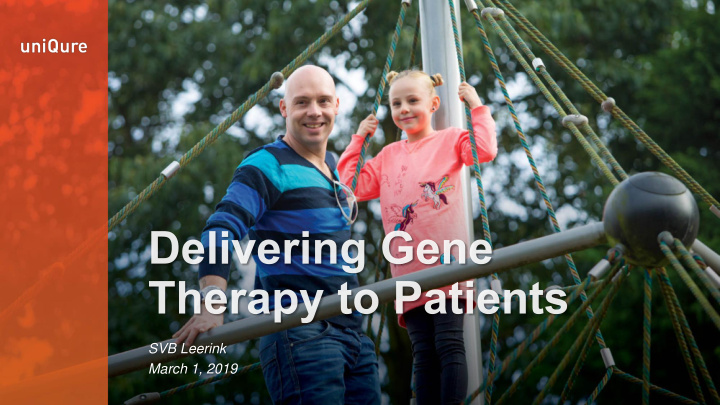



SVB Leerink March 1, 2019
Forward-looking Statements This presentation contains forward-looking statements. All statements other than statements of historical fact are forward-looking statements, which are often indicated by terms such as “anticipate,” “believe,” “could,” “estimate,” “expect,” “goal,” “intend,” “look forward to,” “may,” “plan,” “potential,” “predict,” “project,” “should,” "will,” “would” and similar expressions. Forward-looking statements are based on management's beliefs and assumptions and on information available to management only as of the date of this presentation. These forward-looking statements include, but are not limited to, statements regarding the development of our gene therapies, the success of our collaborations, and the risk of cessation, delay or lack of success of any of our ongoing or planned clinical studies and/or development of our product candidates. Our actual results could differ materially from those anticipated in these forward-looking statements for many reasons, including, without limitation, risks associated with collaboration arrangements, our and our collaborators’ clinical development activities, regulatory oversight, development of product candidates, product commercialization and intellectual property claims, as well as the risks, uncertainties and other factors described under the heading "Risk Factors" in uniQure’s Annual Report on Form 10-K filed on February 28, 2019. Given these risks, uncertainties and other factors, you should not place undue reliance on these forward-looking statements, and we assume no obligation to update these forward-looking statements, even if new information becomes available in the future. D E L I V E R I N G G E N E T H E R A P Y T O P A T I E N T S M A R C H 2 0 1 9 | 2
Strategic imperatives Develop a proprietary pipeline of gene therapy candidates focused on Pipeline liver-directed and CNS disorders Maintain leadership in commercial-scale manufacturing of AAV gene Manufacturing therapies Enabling Invest and leverage next-generation technologies that optimize and Technologies expand the applicability of gene therapy to patients Intellectual Expand and maintain our leading IP portfolio Property Retain valuable commercial rights Commercialization D E L I V E R I N G G E N E T H E R A P Y T O P A T I E N T S M A R C H 2 0 1 9 | 3
Expanding our proprietary pipeline… D E L I V E R I N G G E N E T H E R A P Y T O P A T I E N T S M A R C H 2 0 1 9 | 4
AMT-061: FIX activity up to 16 weeks post-treatment Increases in FIX Activity up to 51% Main Efficacy Findings: Mean FIX activity at 12 weeks of 38% ❑ Sustained increases in FIX activity ❑ No bleeding events post-infusion ❑ No infusions of replacement therapy ❑ No requirement of immunosuppression Main Safety Findings: ❑ Well-tolerated ❑ No serious adverse events ❑ No inhibitor development D E L I V E R I N G G E N E T H E R A P Y T O P A T I E N T S M A R C H 2 0 1 9 | 5
AMT-061: HOPE-B Phase III pivotal study • Open label, single-dose, multi-center, multi-national trial • Approximately 50 patients with severe and moderately-severe hemophilia B • Patients with AAV5 antibodies will not be excluded • Patients will serve as their own control; 6-month lead-in to establish baseline • Study objectives: • Increase FIX activity • Reduce frequency of bleeding episodes • Decrease use of FIX replacement therapy • Assess efficacy and safety D E L I V E R I N G G E N E T H E R A P Y T O P A T I E N T S M A R C H 2 0 1 9 | 6
AMT- 130: Huntington’s Disease Target product profile • One-time administration of disease-modifying therapy Proprietary miQURE TM silencing platform • Huntington’s AMT-130 • Strong mHTT knockdown in both deep structures and cortex • • 3-7 per 100K people 1 Preclinically shown to be generally safe and well-tolerated • No treatments available • Potential to be first to market • Strong preclinical data • Near-term goal: Initiate clinical study in 2019 1 Rawlins, MD. Neuroepidemiology 2016;46:144-153 D E L I V E R I N G G E N E T H E R A P Y T O P A T I E N T S M A R C H 2 0 1 9 | 7
AMT-130: Phase I/II dose escalation study Efficacy Endpoints IND Cleared – Phase I/II Study Overview Clinical Parameters (e.g. UHDRS) • Multicenter, randomized, double-blinded study • Placebo-controlled with imitation surgery Quantitative Motor Function • Objectives: assess safety, tolerability and efficacy Volumetric MRI and MRS • Two dose cohorts with a total of 25 patients Biomarkers (e.g. mHTT in CSF) • 18-month follow-up (5 years for treated patients) Patient-reported outcomes D E L I V E R I N G G E N E T H E R A P Y T O P A T I E N T S M A R C H 2 0 1 9 | 8
Near-term goals Hemophilia B Complete enrollment in HOPE-B Phase III pivotal study of AMT-061 Huntington’s Initiate dosing of Phase I/II study of AMT-130 Hemophilia A Submit IND for AMT-180 Initiate IND-enabling toxicology study for one additional program Other Programs D E L I V E R I N G G E N E T H E R A P Y T O P A T I E N T S M A R C H 2 0 1 9 | 9
Recommend
More recommend